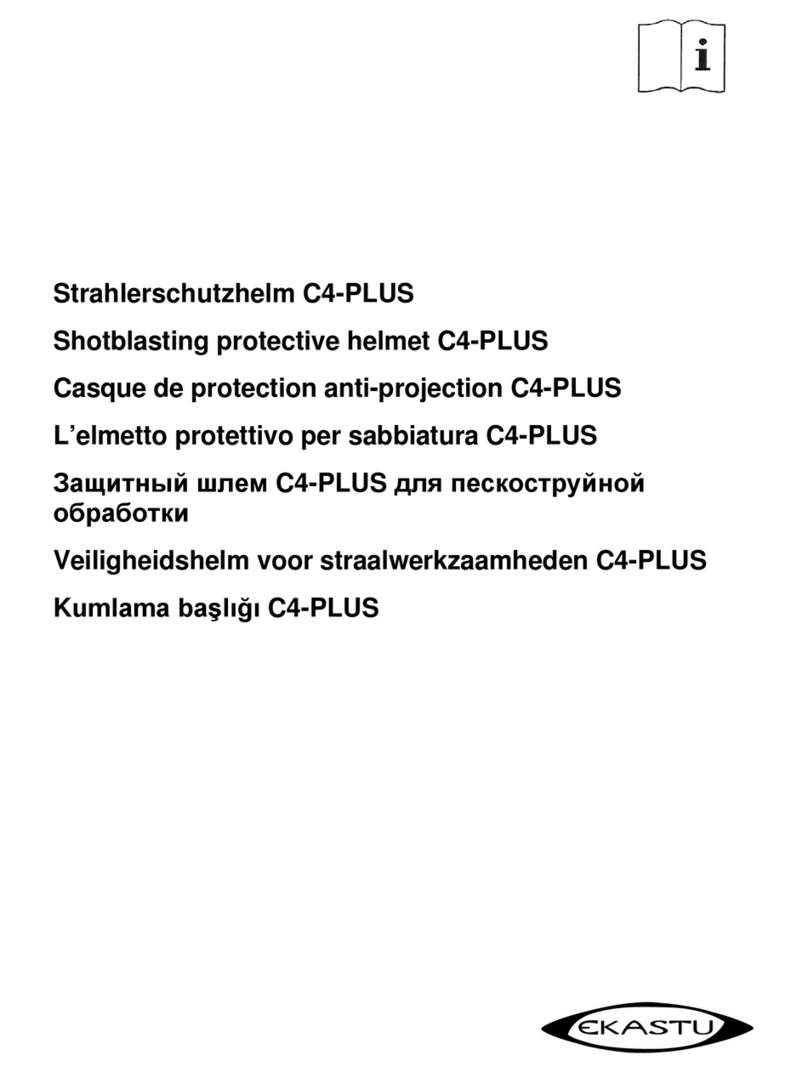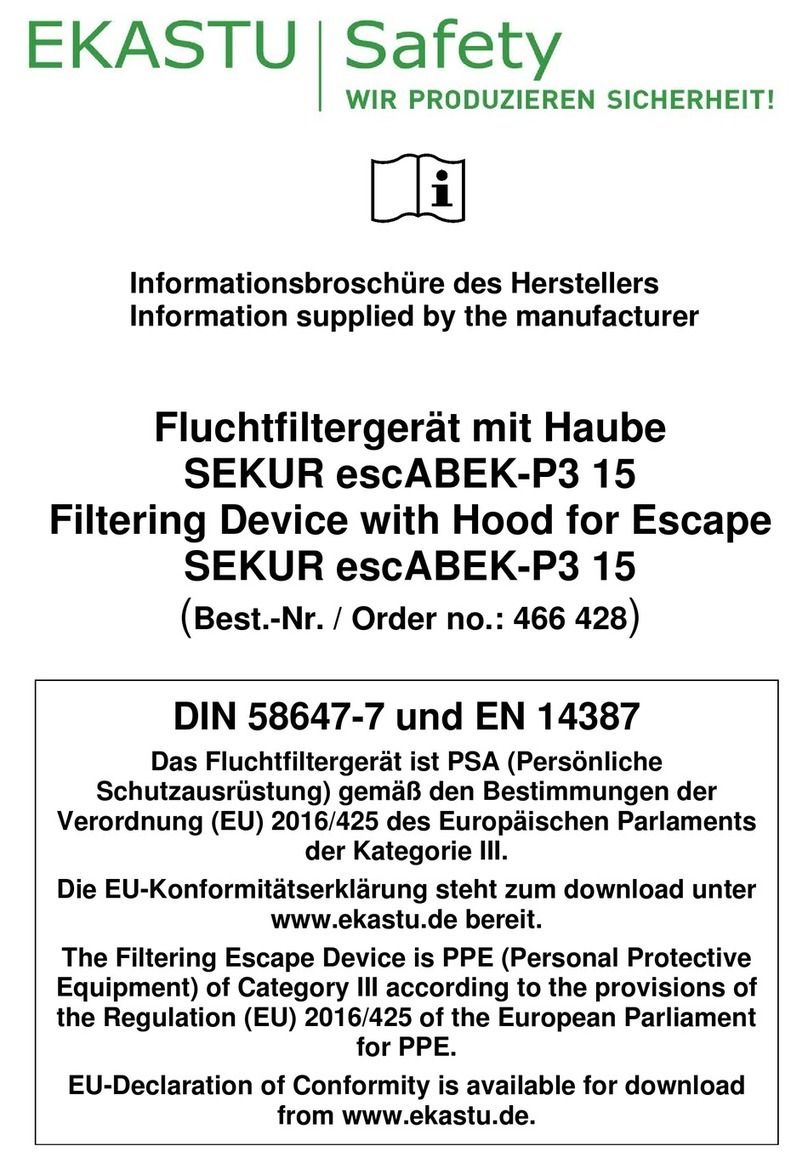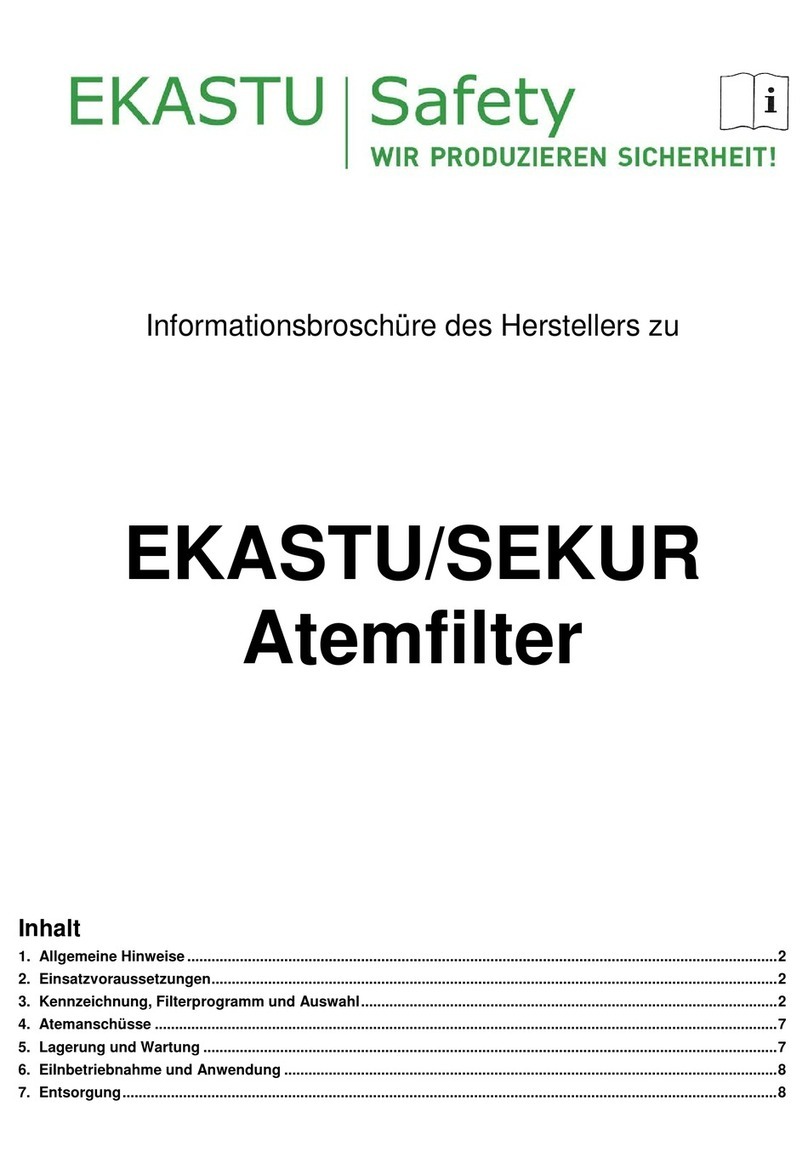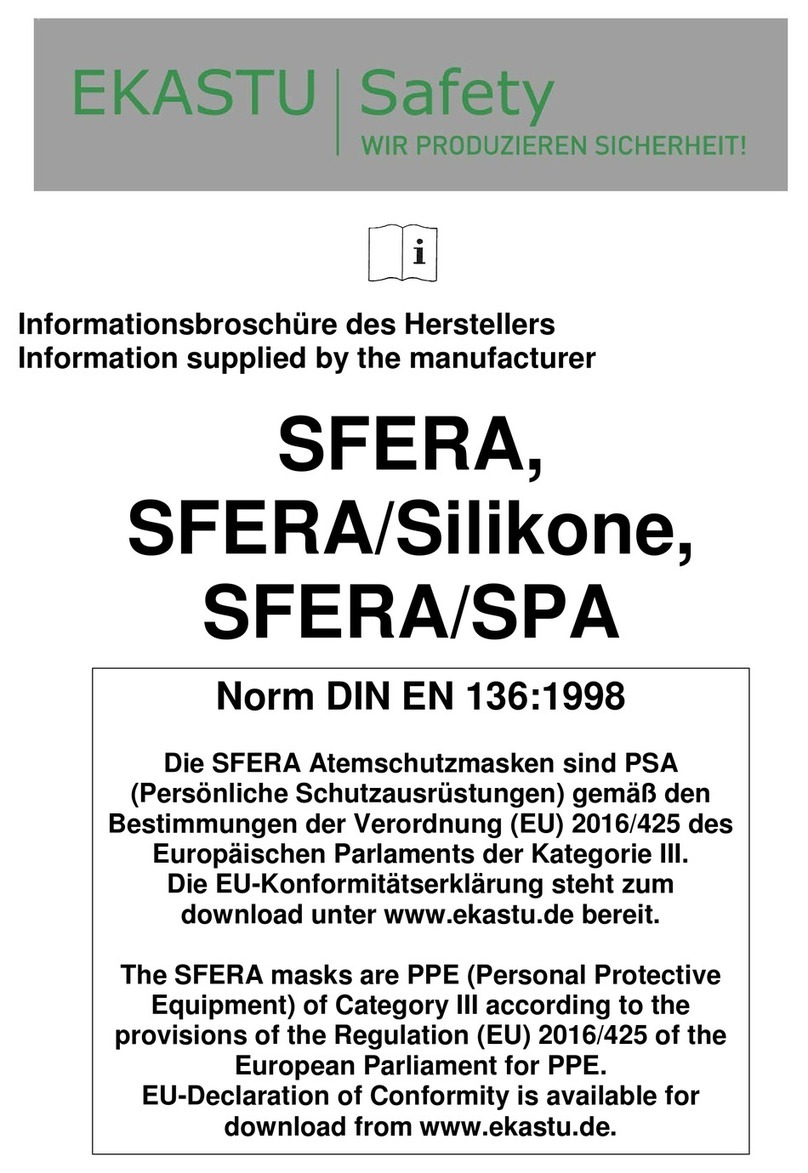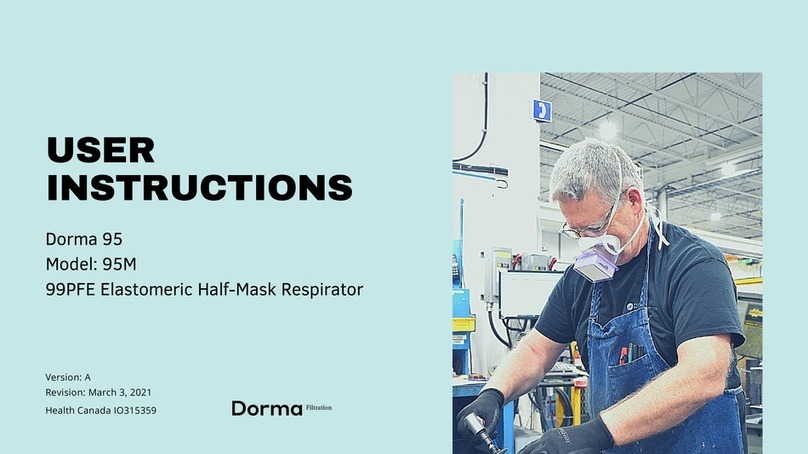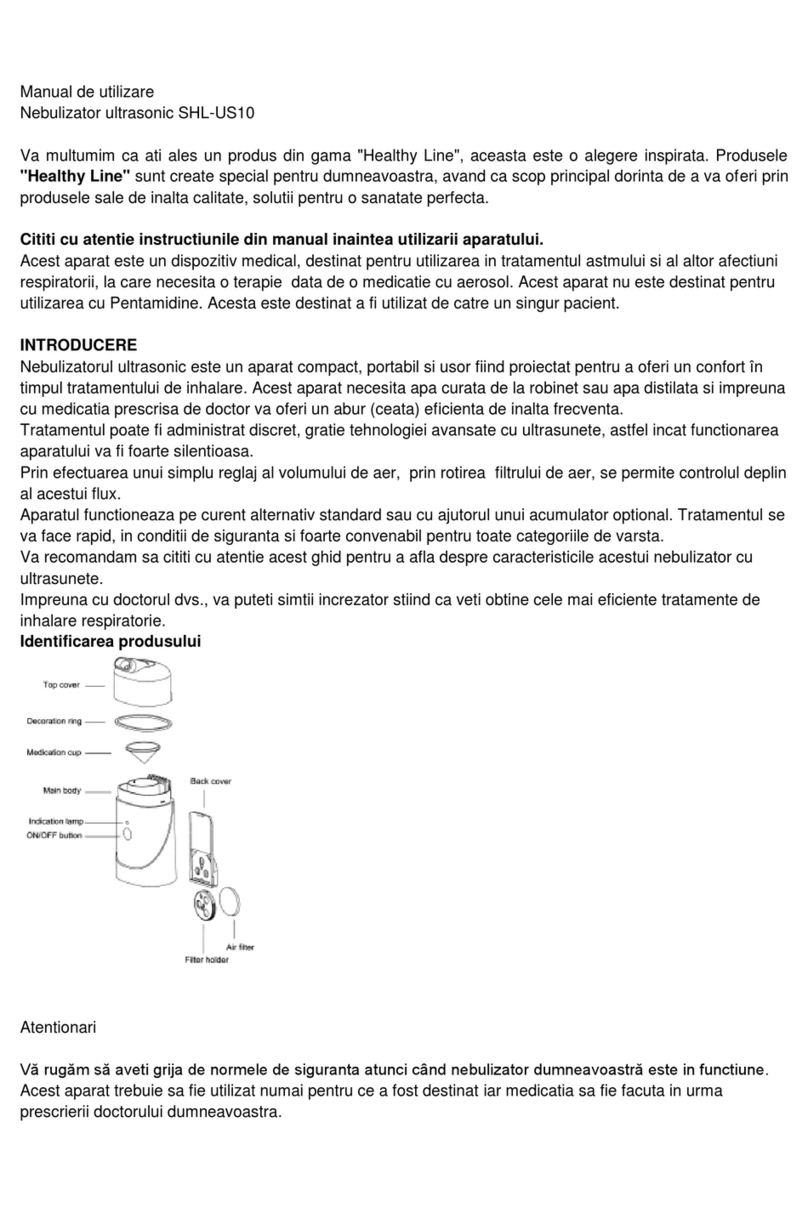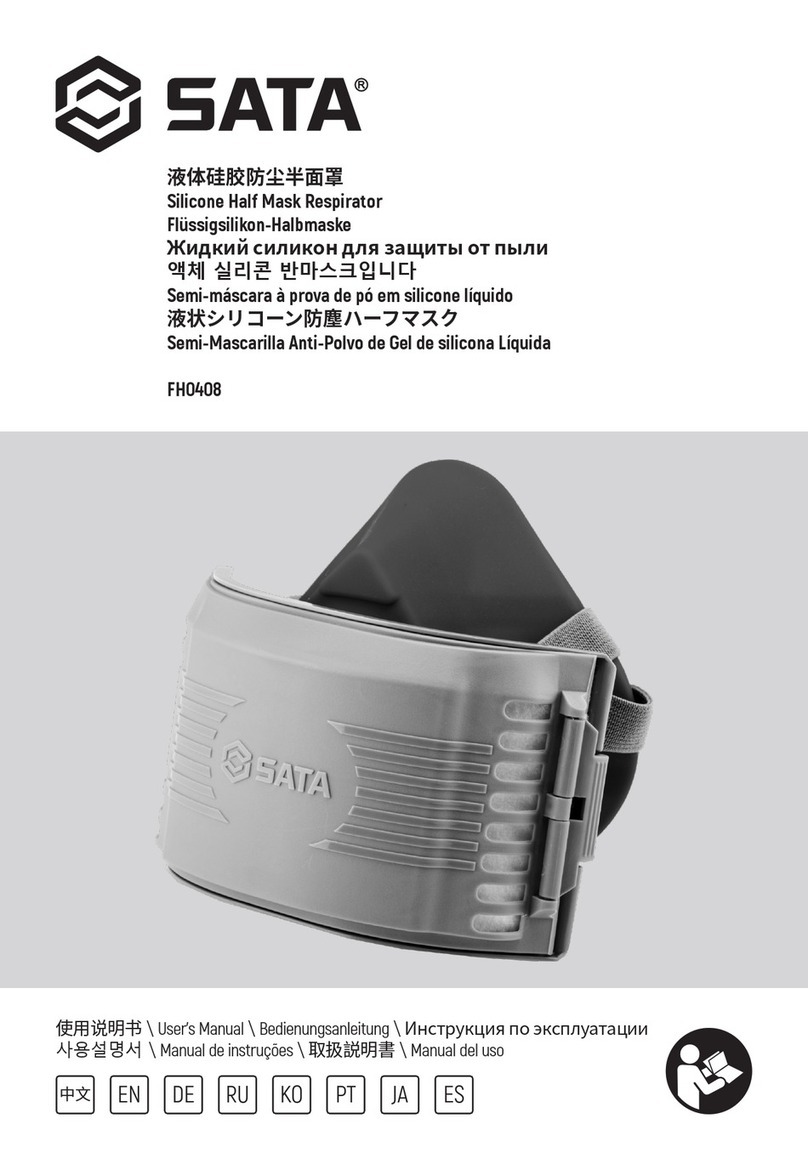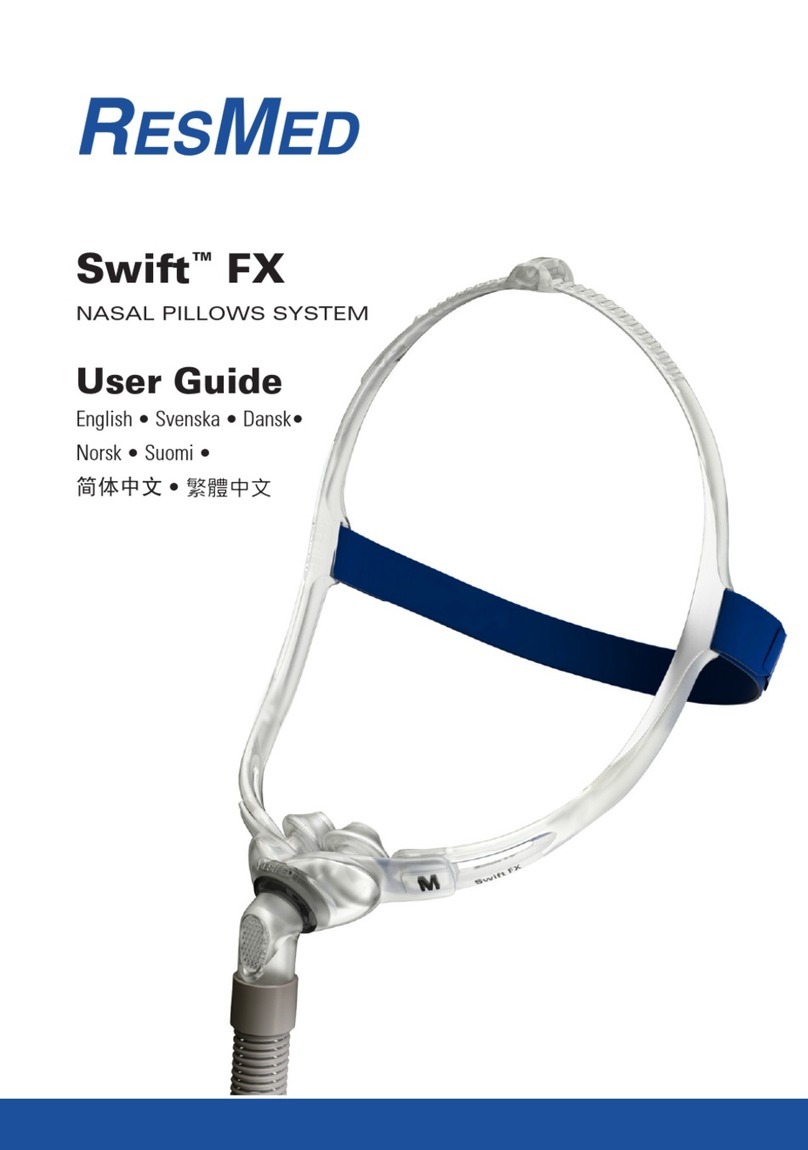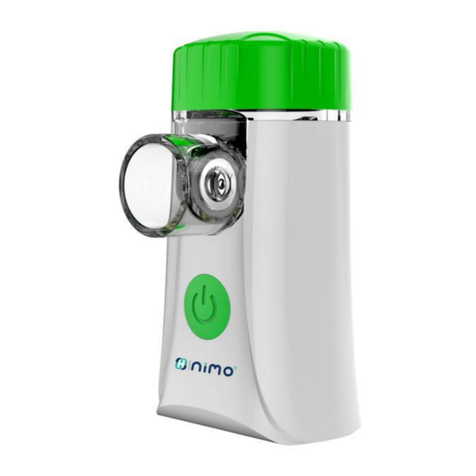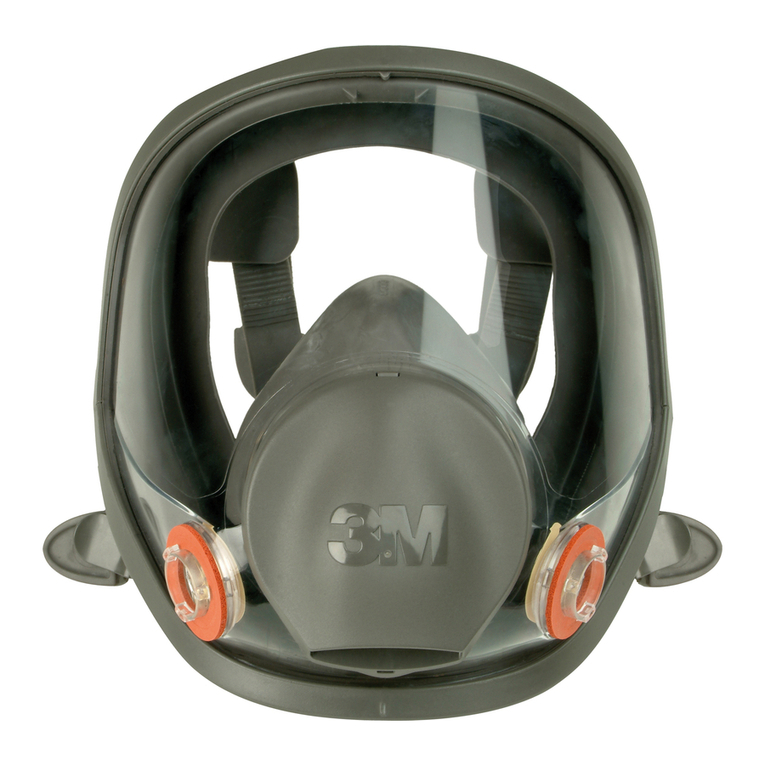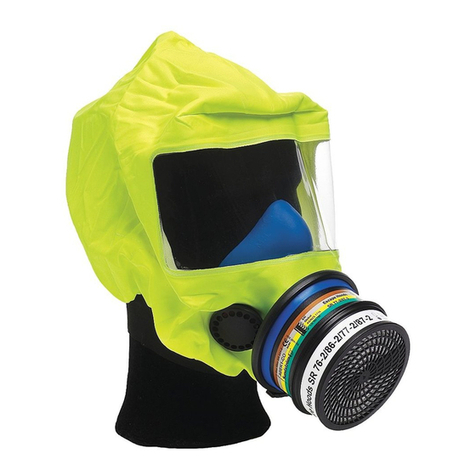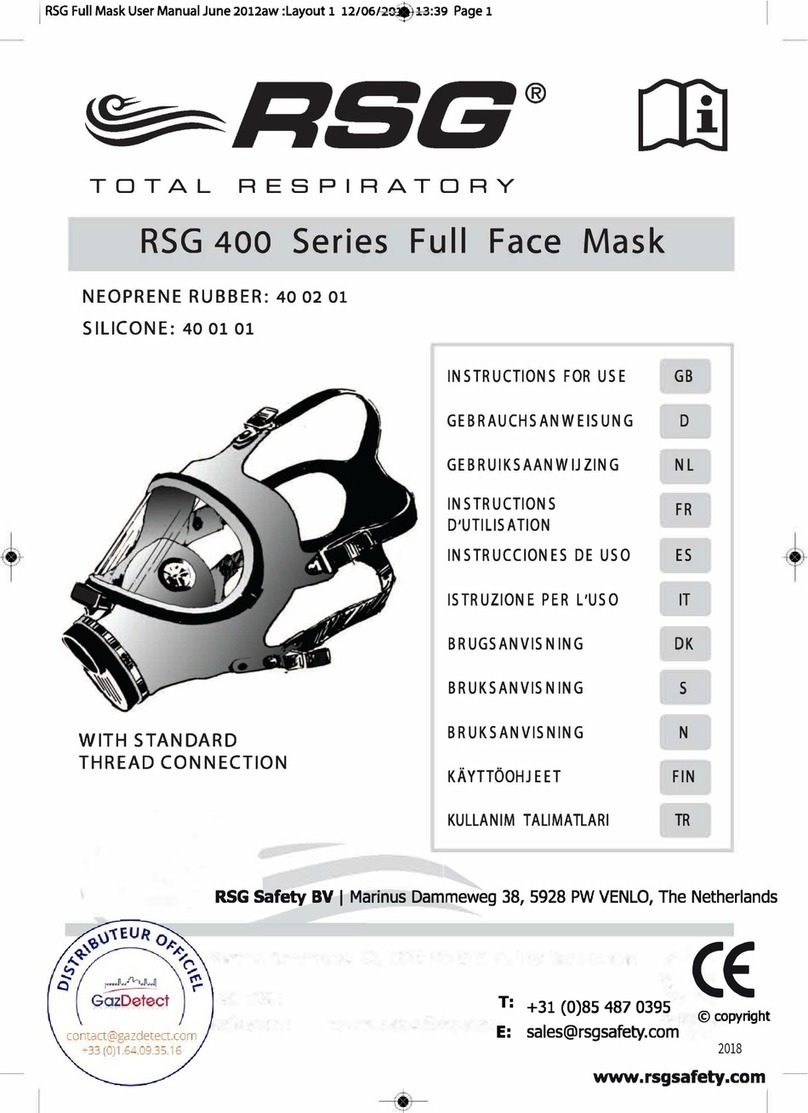ekastu FFP1 Owner's manual

Informationsbroschüre des Herstellers
Information supplied by the manufacturer
Instructions pour l`utilisation
Instrucciones para el uso
Gebruiksaanwijzing
MANDIL FFP1, FFP2, FFP3
DIN EN 149:2001 NR
Diese Filtrierenden Halbmasken sind PSA
(Persönliche Schutzausrüstungen) gemäß
den Bestimmungen der Verordnung (EU)
2016/425 des Europäischen Parlaments der
Kategorie III.
Die EU-Konformitätserklärung steht zum
download unter www.ekastu.de bereit.
These filtering facepieces are PPE of
Category III according to the provisions of
the Regulation (EU) 2016/425 of the
European Parliament for PPE
(Personal Protective Equipment).
EU-Declaration of Conformity is available for
download from www.ekastu.de.

INFORMATIONSBROSCHÜRE DES HERSTELLERS: Filtrierende Halbmaske
ACHTUNG: Filtrierende Halbmasken sind in drei Klassen, nämlich FFP1, FFP2 und FFP3 eingeteilt.
Bevor Sie die folgenden Informationen lesen, prüfen Sie die Klasse des ausgewählten
Atemschutzgerätes. Dies ist auf der Verpackung und dem Atemschutzgerät selbst angegeben.
Es liegt in der Verantwortung des Benutzers das geeignete Atemschutzgerät auszuwählen.
Allgemeine Anweisungen für den Gebrauch:
-Setzen Sie das Atemschutzgerät auf und prüfen Sie die Dichtheit, bevor Sie den kontaminierten
Bereich betreten.
-Tragen Sie das Atemschutzgerät solange Sie den Schadstoffen ausgesetzt sind.
-Benutzen Sie das Atemschutzgerät ausschließlich gemäß dieser Informationsbroschüre, den jeweils
geltenden gesetzlichen Regeln und den Sicherheitsvorschriften der Berufsgenossenschaften insbesondere
die DGUV Regel 112-190 bzw. DIN EN 529 „Atemschutzgeräte – Empfehlungen für Auswahl, Einsatz,
Pflege und Instandhaltung – Leitfaden“.
-Wechseln Sie das Atemschutzgerät sofort, wenn: - das Atemschutzgerät im Gefahrenbereich
abgesetzt wurde, - das Atmen schwer fällt, - der Atemwiderstand ansteigt, - das Atemschutzgerät
beschädigt ist. (bei Atemschutzgeräten die gegen Dämpfe schützen, wenn der Geruch der Dämpfe
wahrgenommen wird)
-Verlassen Sie den Arbeitsplatz sofort, wenn Schwindel oder Übelkeit auftritt.
-Die Gebrauchsdauer der Atemschutzgeräte sind auf eine Arbeitsschicht begrenzt (NR).
-In sauberen und trockenen Räumen bei Temperaturen zwischen +2°C und +55°C lagern.
-Name der notifizierenden Stelle, die in der Konzeptionsphase dieser PSA involviert war:
ITALCERT S.r.l., Viale Sarca 336 20126 MILAN, ITALY (NB id: 0426)
Aufsetzanleitung:
1. Halten Sie das Atemschutzgerät so in der Hand, dass die Bänder frei herunterhängen.
2. Setzen Sie das Atemschutzgerät unter dem Kinn an – den Nasenbügel nach oben.
3. Nehmen Sie das untere Halteband und ziehen es über den Kopf bis in den Nacken. Ziehen Sie jetzt
das obere Halteband auf den Hinterkopf.
4. Nur für Atemgeräte mit verstellbaren Haltebändern: Spannen Sie die Bänder, indem Sie deren freie
Enden nach hinten ziehen. Zu stark gespannte Bänder können Sie wie folgt lockern: mit einer Hand
die Schnalle fassen und den beweglichen Teil von Innen nach Außen drücken.
5. Passen Sie mit beiden Händen den Nasenbügel ihrem Nasenrücken an.
ÜBERPRÜFUNG DES DICHTEN SITZES DES ATEMSCHUTZGERÄTES: Umschließen Sie diese mit
beiden Händen und atmen Sie kräftig aus. Bei Luftaustritt im Nasenbereich ist der Nasenbügel nochmals
nachzuformen, wie oben beschrieben. Bei anderen Undichtigkeiten im Bereich des Maskenrandes, straffen
Sie nochmals die Haltebänder indem Sie sie nach hinten ziehen.
WICHTIG: Wenn Sie kein Atemschutzgerät mit verstellbaren Bändern benutzen, können Sie die
Bänderung durch Knoten verkürzen. Überprüfen Sie danach nochmals den Dichtsitz.
EINSCHRÄNKUNGEN :
Das Atemschutzgerät schützt den Träger nicht vor Gasen und Dämpfen über den jeweiligen
Grenzwerten oder in Umgebungen mit weniger als 17% Sauerstoff. Verwenden Sie das
Atemschutzgerät nicht, wenn die Gefahrstoffe und Konzentrationen unbekannt sind und eine
unmittelbare Gefahr für Leben oder Gesundheit darstellt. Die Atemschutzgeräte können gegen
Gefahrstoffe bis zum: FFP1 4-fachen, FFP2 10-fachen und FFP3 30-fachen des Grenzwertes
eingesetzt werden.
WARNUNG:
Verwenden Sie zur Lagerung und zum Transport die Originalverpackung und schützen Sie die Maske
vor mechanischen und chemischen Risiken.
Die Atemschutzgeräte nur in ausreichend belüfteten Räumen mit genügend hohem Sauerstoffgehalt
verwenden. Nicht in explosiver Atmosphäre verwenden. Der Maskenträger muss den
funktionsgerechten Gebrauch und die praktische Anwendung kennen. Gesichtshaare (Bart) des
Benutzers im Bereich der Maskendichtlinie beeinträchtigen die Schutzwirkung des Atemschutzgerätes
beträchtlich.
ENTSORGUNG:
Unbenutzt: zusammen mit dem Hausmüll.
Benutzt: entsprechend den Entsorgungsvorschriften des jeweiligen Stoffes.

INFORMATION SUPPLIED BY THE MANUFACTURER: Filtering Facepiece
IMPORTANT: Single-use respirators are classified according to one of three categories: FFP1, FFP2
and FFP3. Before reading the following information, check the category to which the respirator belongs,
this is indicated on the packaging and on the respirator. It is the user’s responsibility to ensure that the
respirator provides the necessary level of protection for the type and concentration of the
contaminant(s) in the area where the respirator is intended for use.
DIRECTIONS FOR USE:
-Fit the respirator and check leak-tightness BEFORE entering the contaminated area.
-Wear the respirator for the whole duration of exposure to contaminants.
-Use the respirator in accordance with applicable health and safety regulations e.g. DGUV 112-190 or
DIN EN 529 “Respiratory protective devices – Recommendations for selection, use, care and
maintenance – Guidance document”.
-Discard the respirator and replace with a new one if: the respirator is removed while in a
contaminated area, excessive clogging of the respirator causes breathing difficulty or discomfort, the
respirator becomes damaged.
-The smell of gases and/ or vapors present becomes detectable (for respirators protecting against
gases and/or vapors below threshold value only).
-Leave the contaminated area if dizziness, irritation or other distress occurs.
-The filtering facepiece cannot be used for more than one working shift (8 hours) (NR).
-Store respirators in a dry non-contaminated area between +2°C and +55°C.
-Name of the Notified Body involved in the design stage of the PPE: ITALCERT S.r.l., Viale Sarca 336
20126 MILAN ITALY (NB id: 0426)
FITTING INSTRUCTIONS:
1. Cup the respirator in the hand, allowing the head bands to hang freely.
2. Hold the respirator under chin with the nose piece facing outwards.
3. Place the lower head band around the neck below the ears. Holding the respirator against the face
with one hand, place the top head band above the ears, around the crown of the head.
4. Respirators with adjustable head bands only: while maintaining the position of the respirator, adjust
tension by pulling tab of each head band, (Tension may be decreased by pushing out on the back
of the buckle).
5. Mould the nose area to the shape of the face, running the fingertips of both hands from the top of the
nose piece down both sides while pressing inward.
CHECK FOR LEAK TIGHTNESS (FACIAL FIT) AS FOLLOWS: place both hands over the respirator
and exhale sharply positive pressure should be inside the respirator if you feel air escaping around the
edges, readjust the respirator by tightening the nosepiece and/or increasing tension of the head bands
repeat the procedure until satisfactory face fit has been achieved.
IMPORTANT: In the case of respirators with nonadjustable head bands: if you feel that the head bands
are too loose, you can increase tension by tying a small knot in the head band.
LIMITATIONS TO USE:
Do not use these respirators or enter or stay in an area where:
oxygen concentration is less than 17% (UK-19%) contaminants or their concentrations are unknown or
immediately dangerous to life or health, particulate concentrations exceed levels fixed by applicable
health and safety regulations or protection factor x NPF (Nominal protection factors: 4.5 for FFP1, 12.5
for FFP2 and, 50 for FFP3). Against gases and/or vapors (respirators designated for protection against
gases and/or vapors) concentrations should not exceed threshold value.
WARNING:
When transporting this product, retain in the original packaging and keep away from mechanical and
chemical hazards!
These respirators do not supply oxygen. Do not use in oxygen-deficient atmospheres e.g. tanks or
other poorly-ventilated areas. Do not use in explosive atmospheres. For use by trained and qualified
personnel only. Not for persons, who wear facial hair (e.g. beard).
DISPOSAL:
Unused condition: with normal household waste disposal.
Used condition: according to the requirements of respective substances.

NOTICE D UTILISATION:Demi-Masque filtrant
IMPORTANT: Les masques à usage unique sont classés en trois catégories FFP1 FFP2 FFP3.
Avant de lire les informations ci-dessous, déterminer dans quelle catégorie se trouve le masque
cette categorie est indiquée sur le conditionement et sur le masque.
RECOMMANDATION D EMPLOI:
-Installer le masque et ajuster les élastiques avant d’ entrer dans la zone contaminée
-Porter le masque durant toute la durée d’exposition à des contaminants
-Employer le masque en respect des lois sur la santé et la securité
-Remplacer le masque si:
le masque etant porté dans un environement contaminé une excessive filtration apporte des
difficultés de respiration, si le masque est abimé ( pour les masques protegeant des vapeurs)
l’odeur des vapeurs devient detéctable
-Quitter la zone contaminée en cas d’étourdissement, irriation ou tout autre signe de risque
-Seulement pour usage unique (NR), pas de maintenance requise. Ne pas stocker et/ou reutiliser
après une utilisation
-Eliminer le masque prés usage, usage unique uniquement
-Stocker les masques non utilisés dans leur emballage fermé dans une rone non contaminée entre
+2°C et +55°C.
-Name of the Notified Body involved in the design stage of the PPE: ITALCERT S.r.l., Viale Sarca 336
20126 MILAN ITALY (NB id: 0426)
INSTRUCTIONS POUR LA MISE EN PLACE DU MASQUE:
1. Prendre le masque dans la paume en permettant aux liens de pendre librement
2. Placer le masque sous le menton avec la partie du masque recouvrant le nez sur le dessus
3. Placer le lien du dessous derriere le coup et sous les oreilles Maintenir le masque sur le visage
d’une main, et placer le second élastique autour du crane et au dessus des oreilles.
4. Pour les masques avec élastiques réglables, pendant le maintien du masque sur le visage,
ajuster La tension, (la tension peut être diminuée en poussant sur le derrière de la boucle)
5. Ajuster la barrette nasalle en poussant sur les deux cotés de la barette nasalle. Vérifier
l’étancheité du masque comme suit: placer les deux mains sur le masque et expirer
vigoureusement *une aspiration doit se sentir à l’interieur du masque.Si vous sentez des fuites
autour de la bordure reinstaller le masque selon la procédure jusqu'à un résultat satisafaisant.
IMPORTANT: dans le cas des masques à liens non ajustable, vous pouvez augmenter la tension
en effectuant un nœud derrière le crane sur le lien
RESTRICTIONS D EMPLOI:
Ne pas utiliser ces masques pour entrer ou rester dans une zone où:
La concentration d oxygène est inférieure à 17 % (UK-19%),
Les contaminants ou leur concentration sont inconnues ou immédiatement dangeureuse pour la
santé, ou mortels.
Les contentrations de particules excèdent les niveaux fixés par les lois sur la santé et la sécurité,
ou le facteur de protection x NPF, lequel est le plus faible. Les facteurs de protection nominaux
sont de : 4,5 pour FFP1, 12,5 pour FFP2 et 50 pour FFP3.
Des gaz et/ou vapeurs sont présentes, éxcepté pour les masques reconnus comme protection
contre les vapeurs, dans ce cas les vapeur ne doivent pas exceder NPF. Les masques protegeant
contre les vapeurs organiques ne doivent pas être utlisés contre les vapeurs acides et vice-versa.
AVERTISSEMENT:
Ne pas utliser pour la lutte contre le feu. Ces masques ne fournissent pas d’oxygène. Ne pas
utiliser dans des atmosphères pauvres en oxygène, comme des citernes ou autres zones peu
ventilées. (voir restrictions d’emploi). Ne pas utiliser dans les atmosphères explosives. Utilisation
uniquement par du personnel entrainé et qualifié. L ‘étancheité est peu probable si le masque est
porté sur une barbe ou sur des visages non rasés

FOLLETO INFORMATIVO: Mascarilla autofiltrante
IMPORTANTE :Lasmascarillas autofiltrantes desechables contra aerosoles sólidos y líquidos, se clasifican en tres
categorías o tipos: FFP1, FFP2 y FFP3. Antes de leer la información que se detalla a continuación, compruebe qué
tipo de mascarilla tiene intención de utilizar (estáindicado en el embalaje y en la propia mascarilla).Es responsabilidad
del usuario elegir el modelo demascarillaque le proporcione el nivel de protecciónadecuado frente al tipo y
concentración del contaminante(s) presente(s) en la zona de trabajo en la que va a desarrollar su actividad.
INSTRUCCIONES DE USO :
-Póngase la mascarilla y haga la prueba de ajuste-fuga antes de entrar en la zona deriesgo.
-Lleve la mascarilla puesta y bien ajustada durante todo el tiempo que permanezca expuesto a la acción
de los contaminantes.
-Use las mascarillas en conformidad con las exigencias legales nacionales sobre salud e higiene
en el trabajo.
-Deseche la mascarilla y sustitúyala por una nueva si: se la quita o se le cae dentro de la zona
contaminada; se obstruye o satura y le resulta molesto o difícil respirar o si sufre cualquier tipo de
daño o rotura. Los modelos que ofrecen protección frente a vapores orgánicos deberán
sustituirse cuando ud. detecte el olor o sabor del contaminante con la mascarilla puesta.
-Abandone la zona de riesgo si nota mareos, fatiga, náuseas o cualquier otro malestar similar.
-Este tipo de mascarillas son de un sólo (NR) uso, no requieren mantenimiento. Una vez utilizadas, no
las almacene ni las vuelva a usar.
-Deseche la mascarilla después de haberla utilizado (un turno de trabajo, como máximo).
-Conserve las mascarillas en su caja, cerrada y almacénelas en una zona no contaminada, con una temperatura entre
+2ºC y +55ºC.
-Name of the Notified Body involved in the design stage of the PPE: ITALCERT S.r.l., Viale Sarca 336
20126 MILAN ITALY (NB id: 0426)
INSTRUCCIONES DE COLOCACIÓN:
1. Sujete lamascarilla conuna de sus manos, con el clip nasal orientado hacia los dedos y las cintaselásticas de
sujeción colgando libremente.
2. Coloque la mascarilla sobre la cara, de forma que le cubra totalmente la nariz y la boca. El clip nasal debe
quedar orientado hacia arriba.
3. Con una mano sujete la mascarilla sobre su cara, haciendo una suave y firme presión, y con la otra
mano, pase las cintas elásticas sobre su cabeza. La cinta inferior debe situarse por debajo de las orejas,
en la nuca y la superior por encima de ellas.
4. En las mascarillas que incorporan hebillas para el ajuste de las cintas de sujeción, mantenga la mascarilla
sobre la cara y tire de losextremos de las cintas hasta alcanzar la tensión deseada. Para reducir la tensión, levante la
pestaña central de la hebilla para liberar la cinta.
5. Con las dos manos a la vez, ajuste toda la extensión del clip nasal al contorno de su nariz y,
posteriormente, asegúrese de que los bordes de la mascarilla están en contacto directo con su cara.
Comprobacion o prueba de aduste-fuga: Permite verificar si se ha puesto la mascarilla de forma
correcta. Para ello, cubra con las dos manos toda la mascarilla y exhale con fuerza, en ese momento
deberá notar una presión positiva en el interior de la mascarilla. Si detecta fugas de aire a través de los
bordes, habrá que modificar la posición de la mascarilla sobre la cara, reajustar el clip nasal y/o modificar
la posición y tensión de las cintas de sujeción. Repita esta proceso hasta que no detecte fuga alguna.
Importante: En las mascarillas sin cintas elásticas ajustables, se puede aumentar la tensión de las mismas
cambiando ligeramente su posición sobre la cabeza o haciendo pequeños nudos sobre ellas.
LIMITACIONES DE USO:
No use las mascarillas, ni entre o permanezca en la zona deriesgo si: La concentración de Oxígeno es inferior al
17 % (en volumen). Desconoce la naturaleza y/o concentración del agente contaminante o si ésta es sea
inmediatamente peligrosa para la salud y/o la vida. La concentración de partículas supera los límites fijados
por legislación aplicable o si ésta es superior a 4,5 veces el valor TLV/MAC/OEL del contaminante(s) en
caso de que se emplee una mascarilla tipo FFP1, 12 veces para las mascarillas FFP2 y 50 veces para las
mascarillas tipo FFP3. (Factor de Protección Nominal: 4,5 para FFP1; 12,5 para FFP2 y 50 para FFP3).
* Detecta la presencia de gases o vapores en la zona de riesgo, salvo que vaya a emplear una mascarilla
con carbón activo. En este caso, la concentración del contaminante deberá ser inferior a su valor
TL/MAC/OEL. Las mascarillas que ofrecen protección frente a vapores orgánicos no deben emplearse
como protección frente a gases ácidos y viceversa.
AVISOS DE IMPORTANCIA:
No usar en caso de incendio. Estos EPI no aportan Oxígeno. No usar en atmósferas con baja concentración
de Oxígeno, como por ejemplo tanques o zonas poco ventiladas (ver limitaciones de uso). No las utilice en
atmósferas explosivas. Sólo deberán ser utilizadas por personal entrenado y cualificado para ello. En caso de usuarios
con alguna característica física especial o vello facial abundante (barbas, bigotes o patillas), es muy
probable que no se alcancen los requisitos necesarios para conseguir un correcto ajuste de la mascarilla.

GEBRUIKSAANWIJZING: Filterende halfgelaatsmasker
BELANGRIJK: Eenmalig te gebruiken stofmaskers zijn geclassificeerd volgens een van de drie
categorieën FFP1, FFP2, FFP3. Alvorens onderstaande informatie te lezen, dient men na te gaan
tot welke categorie het masker behoort. Dit is aangegeven op de verpakking en op het masker.
Het is de verantwoordelijkheid van de gebruiker om zich er van te verzekeren dat het masker de
nodige mate van veiligheid biedt voor het type en de concentratie van de schadelijke stof(fen) in
de ruimte waar men het masker wil gebruiken.
GEBRUIKSAANWIJZING:
-Neem het masker en controleer het op beschadigingen VOOR het betreden van de ruimte waar
zich de schadelijke stof bevindt.
-Draag het masker gedurende de hele periode waarin men bloot staat aan de schadelijke stof(fen).
-Gebruik het masker in goede gezondheid en overeenkomstig de veiligheidsvoorschriften.
-Vervang het masker indien: *het masker wordt afgenomen terwijl men zich in een ruimte met
schadelijke stoffen bevindt *extreme vervuiling van het masker ademhalingsproblemen of
ongemak veroorzaakt *het masker beschadigt *(voor maskers die beschermen tegen dampen) –
de geur van aanwezige dampen merkbaar wordt.
-Verlaat de ruimte indien duizeligheid, irritatie zich voordoet of indien u onwel wordt.
-Alleen voor eenmalig gebruik (NR), maximale gebruiksduur: 8 uur.
Bewaar niet-gebruikte maskers in hun gesloten verpakking in een droge, niet-vervuilde ruimte
tussen +2°C and +55°C. Geen onderhoud nodig.
-Name of the Notified Body involved in the design stage of the PPE: ITALCERT S.r.l., Viale Sarca 336
20126 MILAN ITALY (NB id: 0426)
HET OPZETTEN VAN HET MASKER:
1. Neem het masker in een hand en druk het licht tegen het gezicht.
2. Pak met de andere hand het onderste elastiek en trek dit over het hoofd tot onder het oor.
3. Plaats het bovenste elastiek boven het oor.
4. Druk de neusbeugel tegen de neus, zodat het masker goed aansluit.
5. Test of het masker goed zit, door beide handen op het masker te plaatsen en krachtig uit te
ademen. Indien lucht ontsnapt, dient u de neusbeugel sterker aan te drukken, of kunt u het
masker verschuiven door de elastiekjes aan te passen.
BELANGRIJK: Bij maskers met niet-verstelbare bandjes: indien u merkt dat de hoofdbandjes te
los zitten, kunt u de spanning vergroten door een knoop te leggen in het bandje.
BEPERKINGEN AAN HET GEBRUIK:
Gebruik dit masker niet in een ruimte waar:
*de zuurstof-concentratie minder is dan 17% (UK-19%) *schadelijke stoffen of hun concentratie
niet bekend zijn of een bedreiging voor de gezondheid zijn *bepaalde concentraties het niveau
overschrijden dat is vastgesteld door gezondheids- en veiligheidsvoorschriften of het niveau
overschrijden van de beschermingsfactor NPF (Nominal Protection Factor: 4.5 voor FFP1, 12.5
voor FFP2 en 50 voor FFP3) *gassen en/of dampen zich bevinden - behalve bij maskers bedoeld
om te beschermen tegen dampen, in het geval dat damp-concentraties niet de NPF overschrijden.
Maskers die beschermen tegen organische dampen mogen niet gebruikt worden als bescherming
tegen bijtende dampen.
WAARSCHUWING:
Gebruik dit masker niet bij brandbestrijding. Dit masker is geen zuurstofmasker. Gebruik dit
masker niet in zuurstofarme ruimtes – b.v. tanks of andere slecht geventileerde ruimtes (zie
‘Beperkingen aan het gebruik’).
Gebruik dit masker niet in een explosieve omgeving. Alleen te gebruiken door getraind en
gediplomeerd personeel. Het is onwaarschijnlijk dat gezichtshaar (b.v. baard) bij de rand van het
masker de werking negatief beïnvloedt.

Technische Informationen / Technical information
TESTS (minimum)
TYPE FFP1
TYPE FFP2
TYPE FFP3
gesamte nach innen gerichtete
Leckage
Total Inward Leakage
<22%
<8%
<2%
Durchlass des Filtermediums
Penetration through the filtering media
<20%
<6%
<1%
Kohlendioxid-Gehalt der Einatemluft
Carbon dioxide content of inhalation air
(%)
<1%
<1%
<1%
Einatem-Widerstand 30 l/min
Inhalation Resistance 30 l/min
<0,6mbar
<0,7mbar
<1mbar
Einatem-Widerstand
95 l/min
Inhalation Resistance 95 l/min
<2,1mbar
<2,4mbar
<3mbar
Ausatem-Widerstand
160 l/min
Exhalation Resistance 160 l/min
<3mbar
<3mbar
<3mbar
Produkte / Range Best.-Nr. / Part No.
MANDIL FFP1 411 110
MANDIL FFP1/V 411 381
MANDIL FFP2 411 181
MANDIL FFP2/V 411 281
MANDIL FFP2/Soft/V 412 084
MANDIL FFP2/Combi/V 411 250
MANDIL FFP3/V 412 183
MANDIL FFP3/Combi/V 412 888
Piktogramme / Piktogramms
Temperaturbereich der Lagerbedingung / storage temperature range Informationsbroschüre des Herstellers beachten /
Consider information supplied by the manufacturer
maximale relative Feuchte der Lagerbedingungen / XX year Ende der Lagerfähigkeit / Max.shelf life
Maximum storage humidity
NR versus R
NR the marking NR, i.e. not-reusable, shows that according to the requirement of EN 149, the respirator must not be used for more than a work
shift (max 8 hours) after being exposed to aerosols
R the marking R, i.e. reusable, shows that according to the requirement of EN 149, the respirator may be used for more than a work shift (max
8 hours) after being exposed to aerosols
CE Kennzeichnung / marking CE 0426
Identifikationsnummer der zertifizierten Prüfstelle, die für die Kontrolle der Produktion zuständig ist: ITALCERT Viale Sarca 336 - 20126 Milano /
with indication of the number identifying the Notified Body who is responsible for the production control: ITALCERT Viale Sarca 336 - 20126 Milano
Manufacturer:
EKASTU Safety GmbH (Group) Tel.: +49(0)7151 975099-0 Internet: www.ekastu.de
Schaenzle 8 • DE 71332 Waiblingen Fax: +49(0)7151 975099-30 eMail: info@ekastu.de
Germany
Distributed by:
EKASTU Safety AG Tel.: +423 380 06 06 Internet: www.ekastu.li
Principality of Liechtenstein
2002- 2018 by EKASTU Safety GmbH, Waiblingen, Germany Gebr_Mandil 12-08.18
This manual suits for next models
2
Table of contents
Languages:
Other ekastu Respiratory Product manuals
